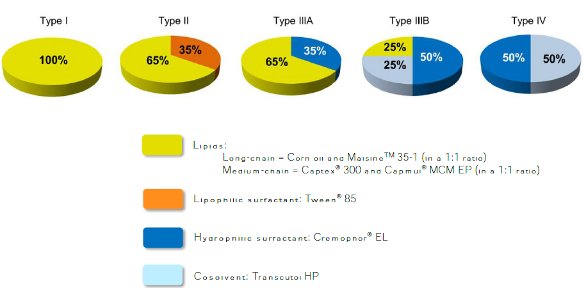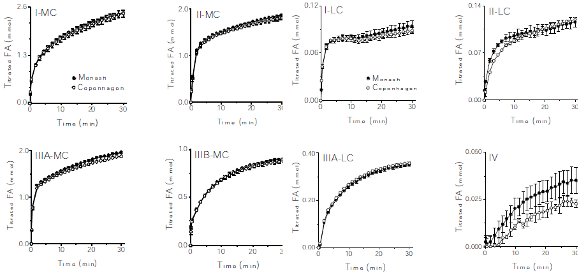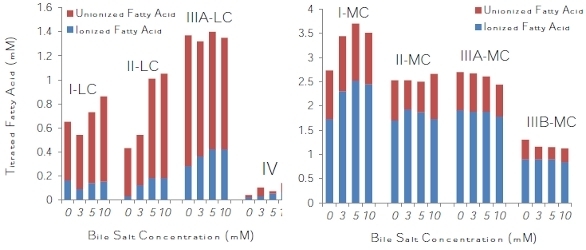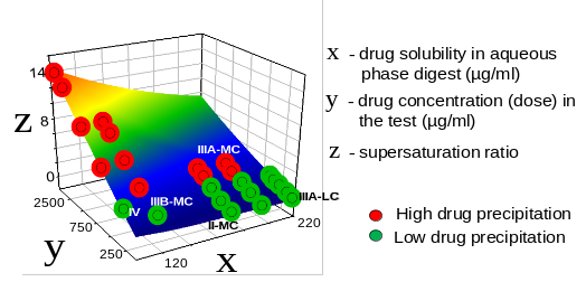Introduction
Alongside the growing number of poorly water-soluble drugs is the use of “enabling formulations” to boost absorption from the gastro-intestinal (GI) tract and support ongoing drug development [1]. Of these enabling formulations, lipid-based formulations (LBFs) offer the potential to improve the oral bioavailability of an API in the fasted state and decrease the “food-effect” via several well-described and unique mechanisms [2], which include:
- Bypassing the dissolution step by delivering the drug in a pre-dissolved form and avoidance of reprecipitation from this pre-dissolved state
- Increasing drug solubilization in the intestinal milieu directly through formulation components formed upon digestion of formulation excipients and indirectly by recruiting natural solubilizers (e.g. bile salts and phospholipid)
- Increasing intestinal drug permeability through inhibition of P-gp and other efflux transporters
- Decreasing first-pass metabolism of the drug through recruitment of intestinal lymphatic processes
LBFs also possess another unique property, namely the capacity to integrate natural lipid digestion and absorption pathways in the small intestine, which provide an efficient conduit for transporting a drug to and through the absorptive intestinal membrane [3-6]. This unique characteristic requires a specific testing protocol for LBFs and, to date, the most effective means of evaluating LBF performance prior to preclinical and clinical studies has been via a “digestion test” (see Figure 1). In this test, a dispersed LBF is digested in a simulated intestinal medium by pancreatic enzymes while the digestion process is followed and the fate of the drug is periodically assessed.
Such digestion tests were first used to assess LBFs by Reymond and Sucker [7], MacGregor et al. [8], and Zangenberg et al. [9], before being shown by a team at the Monash University (Melbourne Australia) to be more effective than dispersion/dissolution tests in predicting the in vivo performance of LBFs [10-13]. Later work [14, 15] has also confirmed the utility of this model in better predicting the in vivo performance of LBFs. In recognition of its utility, the digestion test was subsequently implemented at Capsugel’s R&D Centers in Strasbourg and Boston in 2009 and 2010, respectively, to support LBF development programs. This in vitro tool has subsequently been used in numerous projects to better identify the best performing and most robust LBFs prior to in vivo assessment [16]. Alongside the Lipid Formulation Classification System (LFCS) proposed by Pouton, which focused initially on classifying LBFs based on excipient composition [17], the digestion test has afforded more rational LBF design.

Figure 1: Schematic drawing and a photograph of a lipid digestion model used for the
in vitro evaluation of LBFs. In short, a mixture of pancreatic enzymes is added into a temperature controlled reaction vessel that contains the LBF dispersed in a simulated intestinal medium. Digestion of formulation excipients (lipids and ester-containing surfactants) liberates fatty acid molecules, and the resultant drop in pH is detected by a pH-stat (a commonly used apparatus for pKa and water content determinations) prompting the automatic titration of NaOH into the reaction vessel via an autoburette dosing unit to maintain a constant pH. The titration rate and total amount of NaOH added provides a measure for the rate and extent of digestion of the LBFs. Samples can be taken at regular intervals during the digestion testing for further analysis on the fate of the drug under investigation. The drawing on the left was taken from Porter et al. [2]
Introducing the LFCS Consortium
While in vitro digestion tests undoubtedly provide better insights into the in vivo performance of an LBF, interpretation of data obtained from different laboratories was hampered by a lack of standardized test conditions and well-defined performance criteria. These shortcomings were recognized by leaders in the field, prompting a team from Monash University and Capsugel to co-establish the LFCS Consortium – a not-for-profit collaboration between groups in academia (Monash University, University of Copenhagen and Marseille CNRS) and industry (Capsugel, Sanofi, Gattefossé, Merck Serono, Bristol-Myers Squibb, Roche, Actelion and NicOx) with the following objectives [18]:
- To identify LBF key performance criteria
- To validate and publish universal Standard Operating Procedures to assess LBF performance
- To initiate an appropriate dialogue with pharmaceutical regulatory bodies (EMEA, FDA) to establish regulatory guidelines for evaluating the performance of LBFs.
The LFCS Consortium has been active since 2010 and has since carried out a systematic evaluation of a diverse range of LBFs across a number of in vitro digestion test conditions. Findings from the first year were presented at the AAPS Annual Meeting in 2011 before being converted into two recently published research articles [19, 20]. The key findings of this important work in the LBF field are now briefly summarized. The way in which these findings enable a more QbD approach in LBF development is also described.
In Vitro Digestion Characterization of Drug-Free LBF
The LFCS Consortium has investigated a diverse range of LBFs covering all types defined by Pouton [17], namely simple oil solutions (Type I) to self-emulsifying drug delivery systems or SEDDS (Type II), self-(micro)-emulsifying drug delivery systems or SMEDDS (Type IIIA/B) and lipid-free surfactant/cosolvent formulations (Type IV) as depicted in Figure 2. The variation in the dispersibility and digestibility of these different formulations was considered critical in ensuring that established in vitro test methods are applicable across a wide range of LBFs. While the formulations in Figure 2 are all liquid at 37°C, the consortium has more recently turned its focus also to semi-solid lipid formulations.

Figure 2: The composition of the lipid-based formulations (LBFs) investigated by the LFCS Consortium. LC (long chain) and MC (medium chain) LBFs were classified according to the Lipid Formulation Classification System [17].
As Monash and Copenhagen universities were operating different protocols for digestion testing prior to the LFCS Consortium, it was necessary to harmonize and establish baseline conditions. The harmonized conditions for digestion are described in Table 1. These LFCS Consortium conditions provide biorelevant fasted state concentrations of bile salt, phospholipid and calcium, and delivered a workable baseline from which the effect of different digestion test conditions could be explored.
Table 1: Composition of the LFCS digestion medium (pH 6.5)
Along with the digestion test medium, efforts were also made to standardize the test apparatus (see Figure 3) and protocol across the two laboratories. Titration profiles that track LBF digestion (via pH change) shown in Figure 3 confirm the reproducibility of the LFCS test, both within laboratories as evidenced by the small standard deviation bars, and between laboratories as evidenced by the extensive overlapping of the titration profiles [19]. This result was the first LFCS Consortium milestone as the capacity to harmonize digestion testing across different laboratories was central to its overall objectives. Titration profiles such as those in Figure 3 provide valuable insights into rate and the extent of LBF digestion, which is also valuable to the understanding of LBF performance in vivo. For example, rapidly digested LBFs will exhibit a dramatic change in their physicochemical properties in the small intestine, and in these cases, the fate of the drug following digestion becomes of critical importance to performance.

Figure 3: Fatty acid (FA) titrated during the
in vitro digestion of medium-chain (MC) and long-chain (LC) containing LBFs and lipid-free Type IV LBF tested in Monash and Copenhagen laboratories. Digestion was initiated at t = 0 min on addition of pancreatin, and pH was maintained constant at pH 6.5. Taken from [19].
Effect of Bile Salt/Phospholipid on LBF digestion
In the small intestine, the presence of dietary and formulation lipids will stimulate the secretion of bile salt (BS) and phospholipids (PL) to facilitate the digestion process [21]. In the Fasted State Simulated Intestinal Medium (FaSSIF-v2) proposed by the Dressman group [22], sodium taurocholate and lecithin are used at 3 mM and 0.2 mM concentrations, respectively. The literature, however, indicates that the BS/PL ratio decreases in response to lipid [23], and as a result, digestion models commonly employ a higher BS/PL ratio of 4:1. At this ratio, 0.75 mM phospholipid cannot be solubilized by 3 mM sodium taurocholate as this BS concentration is below its respective CMC [24]. As dihydroxyl BS possess much lower CMC values, sodium taurodeoxycholate (NaTDC) was used by the LFCS Consortium, especially as it was shown to effectively mimic the lipid solubilization properties of a mixture of synthetic BS that matches the typical BS secretion in the human gall bladder [20].
In the fed state, intestinal bile salt concentrations are elevated. To date, however, the LFCS Consortium has focused on LBF performance evaluations in conditions mimicking the fasted state as there is a general consensus that food will more often than not increase the bioavailability of a poorly water-soluble drug. Fasted state conditions are therefore more challenging to formulation performance. Hence the objective of LBF development is to identify formulation(s) that will also perform optimally in the fasted state (to therefore minimize potential risks of a food-effect).
Effects of intra- and inter-subject variations in BS concentrations have been evaluated. Indeed, the LFCS Consortium evaluated the digestion of all LBFs in Figure 2 at 0/0, 3/0.75, 5/1.25 and 10/2.5 mM concentrations of NaTDC/PL [20]. From the results, which are summarized in Figure 4 with the total fatty acid concentration providing a measure of LBF digestion, it was firstly concluded that increasing BS/PL concentration promoted the digestion of more lipophilic LBF (e.g. Type I-LC and Type I-MC formulations) presumably as BS has the capacity to promote pancreatic lipase anchoring to the surface of the oil droplets and since BS assists in the solubilization of digestion products as they form at the oil:water interface. Notwithstanding this positive effect of BS on LBF digestion, lipophilic LC LBF (Type I-LC and II-LC) remained incompletely digested (<75%) in the in vitro test, and their digestion extent did not greatly increase above a 5/1.25 mM BS/PL concentration. Self-emulsifying LBFs containing MC lipids (Type II-MC, IIIA-MC and IIIB-MC) on the other hand were almost completely digested in the absence of BS/PL, and as a result, the digestion of these formulations was largely insensitive to changing BS/PL concentration.
In some cases, BS/PL concentration had a tendency to affect the concentration of titrated (ionized) fatty acid but not the overall extent of LBF digestion (e.g. the IIIA-LC LBF in Figure 4). This finding first of all warns against using only concentrations of ionized fatty acid to infer the extent of LBF digestion. Secondly, it was said by the authors that BS/PL concentration may be influencing the acidity of fatty acids (i.e. the unionized/ionized ratio), presumably by changing the molecular organization of fatty acids following colloidal restructure [20]. It is also immediately clear fromFigure 4 that the unionized/ionized FA ratio is highly formulation dependent, with trends toward increasing FA ionization with increasing LBF hydrophilicity and on switching from LC to MC lipid. A greater proportion of MC FA will therefore be ionized at intestinal pH, and since this will influence the proportion of digestion products present within the colloidal phase, FA ionization will impact the type of colloids that will form and, ultimately, drug solubilization.

Figure 4: The effect of bile salt (NaTDC) concentration on the concentration of ionized/unionized fatty acid liberated on digestion of eight LBFs at pH 6.5. Unionized fatty acid was detected at the end of the test by back-titrations to pH 9. Replotted data taken from [20].
Effect of Drug Loading on Drug Solubilization and LBF Performance
Like other enabling technologies, the drug/excipient ratio can impact the performance of LBFs. Using a model poorly water-soluble drug (danazol), the LFCS Consortium has explored the impact of drug loading on the digestion of eight LBFs and effects on total drug solubilization [20]. Unless developing a lipid suspension, the drug loading in LBFs is limited by its solubility in the formulation components. Each LBF was loaded with the drug at concentrations that were between 20-90% of the saturated drug solubility in the formulation. The authors concluded that this particular drug did not influence dispersibility or digestibility of the different LBFs. In terms of drug solubilization, LBFs comprising >50% LC lipid could support an increasing drug load without the risk of drug precipitation as the LBF is digested. In contrast, MC lipid and lipid-free Type IV LBFs all showed a trend toward drug precipitation as drug load increased [20].

Figure 5: A 3-dimensional surface plot to illustrate the relationship between drug loading (captured by the y-axis), drug solubility in the digested LBF (x-axis) and supersaturation extent (z-axis) overlaid with the performance data of five LBFs containing increasing danazol drug loadings.
The authors rationalized precipitation risk during LBF digestion to supersaturation theory and in doing so identified a threshold maximum supersaturation ratio (SRM) that clearly marked the degree of supersaturation required to trigger drug precipitation. SRM is simply the ratio between the absolute drug concentration in the test and drug solubility in the digested LBF, which is measured in a separate experiment using crystalline drug. Increasing drug loading will therefore increase the SRM value as shown in Figure . Below a SRM of 2.5, there was negligible drug precipitation irrespective of the LBF type, while above this threshold SRM value, drug precipitation was evident. The parameter SRM therefore provides a new performance indicator for lipid formulations since a SRM >2.5 is associated with a higher risk of drug precipitation as an LBF is digested.
Implementing LFCS Consortium Learnings and QbD in LBF Development
Many pharmaceutical companies will often turn to companies with expertise in LBF design, testing and manufacturing to expedite the drug development process. These companies must therefore identify the best performing LBF, confirm adequate stability and manufacture clinical batches of the final product under GMP conditions. All of these steps must usually be performed within pre-determined timeframes. Strategies that afford more efficient LBF selection within the given timeframes are therefore key to success in this LBD development process.
Traditional approaches to LBF design have often been trial and error based since the lack of discriminatory power offered by simple dissolution tests places a heavy burden on preclinical studies to identify the most robust lipid-based formulation. However, over the last few years, Capsugel has been utilizing its lipid expert system, which uses an extensive database of experimentally generated phase diagrams to guide formulation development, [25], and digestion tests as part of its rational LBF design package for accelerated drug development. This has resulted in the development of lipid-based formulations which have been proven to increase the bioavailability for more than 20 pharmaceutical compounds. Table 2 gives an overview of six LBF that all resulted in a significant increase in in vivo bioavailability over non-lipid formulations.
Now, in response to current unmet needs, the LFCS Consortium looks to establish standardized conditions for in vitro testing of LBFs and propose new performance criteria that facilitate LBF design and selection to promote QbD practices within the LBF field. The LFCS Consortium digestion test is inexpensive (~$1 per test), efficient and has been shown to generate consistent results across different laboratories. The findings also provide much needed insights into the key factors that impact LBF performance, such as drug load and supersaturation, and a more accurate method to measure LBF digestion.
The digestion test conditions used within the LFCS Consortium have since been integrated within the DFS project development process to help ensure that robust formulations are developed based on the very best techniques and most up-to-date scientific understanding of LBF.
Table 2: Physicochemical, biological parameters and in vitro/in vivo performance results for six selected New Chemical Entities (NCE)

Author Biographies
Hywel Williams, Ph.D., is a Senior Scientist in Formulation and Pharmaceutical Product Development in Cambridge, MA, part of Capsugel’s Dosage Forms Solutions (DFS) business unit. His principal role is to design and evaluate enabling formulations for oral drug delivery using knowledge of the physicochemical and biopharmaceutical properties of the drug. Dr. Williams holds a Ph.D. in Pharmaceutical Sciences from the University of Nottingham, UK and has extensively published original research in the lipid-based drug delivery field.
Annabel Igonin, Ph.D., is the Pharma Development Manager at Capsugel's Strasbourg, France site, part of the Dosage Forms Solutions (DFS) business unit. Her primary role is to manage all aspects of lipid formulation development projects. She is pharmacist from the University of Lyon, France and has worked for Capsugel for more than 10 years.
Eduardo Jule, Ph.D., is Senior Manager of Formulation and Pharmaceutical Development in Cambridge, MA, part of Capsugel’s Dosage Forms Solutions (DFS) unit. He oversees all aspects of lipid-based formulation development predominantly for North American client projects, from feasibility to scale-up and manufacturing. Dr. Jule spent several years in Business Development with NanoCarrier in Japan, then with Capsugel in Belgium before returning to Research & Development. Dr. Jule holds a PhD in Materials Science Engineering from the University of Tokyo, Japan.
Jan Vertommen, Ph.D., is the Director of Development Center Pharma at Capsugel's Strasbourg, France site, part of the Dosage Forms Solutions (DFS) business unit. He leads teams responsible for product development based on well-established technologies, such as lipid-based formulation encapsulation, and new Capsugel technologies. As a Qualified Person, he also supervises clinical manufacturing in Strasbourg. Dr. Vertommen obtained his Ph.D. from the Catholic University of Leuven, Belgium. He has been with Capsugel for more than 10 years.
Hassan Benameur, Ph.D., is Senior Director of Pharmaceutical Sciences in Capsugel’s Dosage Forms Solutions (DFS) business unit and is based in Strasbourg, France. He leads pharmaceutical strategy to maximize business opportunities from pre-formulation to manufacturing using a systematic and rational approach. Dr. Benameur obtained his Ph.D. from the School of Pharmacy at the Free University of Brussels. He has been with Capsugel for 11 years. He is also the founder and chairman of the LFCS Consortium.
References
- Williams, H.D., et al., Strategies to address low drug solubility in discovery and development. Pharmacological Reviews, 2013. 65(1): p. 315-499.
- Porter, C.J.H., N.L. Trevaskis, and W.N. Charman, Lipids and lipid-based formulations: optimizing the oral delivery of lipophilic drugs. Nature Reviews Drug Discovery, 2007. 6(3): p. 231-248.
- Yeap, Y.Y., et al., Intestinal bile secretion promotes drug absorption from lipid colloidal phases via induction of supersaturation. Molecular Pharmaceutics, 2013. 10(5): p. 1874-1889.
- Yeap, Y.Y., N.L. Trevaskis, and C.J. Porter, The potential for drug supersaturation during intestinal processing of lipid-based formulations may be enhanced for basic drugs. Molecular Pharmaceutics, 2013. 10 (7): p. 2601-2615.
- Yeap, Y.Y., N.L. Trevaskis, and C.J. Porter, Lipid Absorption Triggers Drug Supersaturation at the Intestinal Unstirred Water Layer and Promotes Drug Absorption from Mixed Micelles. Pharmaceutical Research, 2013. 30(12): p. 3045-3058.
- Williams, H.D., et al., Lipid-based formulations and drug supersaturation: Harnessing the unique benefits of the lipid digestion/absorption pathway. Pharmaceutical Research, 2013. 30(12): p. 3059-3076.
- Reymond, J.P. and H. Sucker, In vitro model for ciclosporin intestinal absorption in lipid vehicles. Pharmaceutical Research, 1988. 5(10): p. 673-676.
- MacGregor, K.J., et al., Influence of lipolysis on drug absorption from the gastro-intestinal tract. Advanced Drug Delivery Reviews, 1997. 25(1): p. 33-46.
- Zangenberg, N.H., et al., A dynamic in vitro lipolysis model I. Controlling the rate of lipolysis by continuous addition of calcium. European Journal of Pharmaceutical Sciences, 2001. 14(2): p. 115-122.
- Porter, C.J.H., et al., Use of in vitro lipid digestion data to explain the in vivo performance of triglyceride-based oral lipid formulations of poorly water-soluble drugs: Studies with halofantrine. Journal of Pharmaceutical Sciences, 2004. 93(5): p. 1110-1121.
- Porter, C.J.H., et al., Susceptibility to lipase-mediated digestion reduces the oral bioavailability of danazol after administration as a medium-chain lipid-based microemulsion formulation. Pharmaceutical Research, 2004. 21(8): p. 1405-1412.
- Cuine, J.F., et al., Increasing the proportional content of surfactant (Cremophor EL) relative to lipid in self-emulsifying lipid-based formulations of danazol reduces oral bioavailability in beagle dogs. Pharmaceutical Research, 2007. 24(4): p. 748-757.
- Cuine, J.F., et al., Evaluation of the impact of surfactant digestion on the bioavailability of danazol after oral administration of lipidic self-emulsifying formulations to dogs. Journal of Pharmaceutical Sciences, 2008. 97(2): p. 995-1012.
- Han, S., et al., Lipid-based formulations to enhance oral bioavailability of the poorly water-soluble drug anethol trithione: effects of lipid composition and formulation. International Journal of Pharmaceutics, 2009. 379(1): p. 18-24.
- Dahan, A. and A. Hoffman, Use of a dynamic in vitro lipolysis model to rationalize oral formulation development for poor water soluble drugs: correlation with in vivo data and the relationship to intra-enterocyte processes in rats. Pharmaceutical Research, 2006. 23(9): p. 2165-2174.
- Igonin, A., J. Vertommen, and H. Benameur. Physical and Biological Parameters of Poorly Bioavailable Compounds That Influence the Development of Lipid-Based Oral Drug Delivery Systems. in Annual Meeting of the Academy of the American Pharmaceutical Scientists. 2012. Chicago; USA.
- Pouton, C.W., Formulation of poorly water-soluble drugs for oral administration: Physicochemical and physiological issues and the lipid formulation classification system. European Journal of Pharmaceutical Sciences, 2006. 29(3-4): p. 278-287.
- Gao, P., et al., Characterization and Optimization of AMG 517 Supersaturatable Self-Emulsifying Drug Delivery System (S-SEDDS) for Improved Oral Absorption. Journal of Pharmaceutical Sciences, 2009. 98(2): p. 516-528.
- Williams, H.D., et al., Toward the establishment of standardized in vitro tests for lipid-based formulations: 1) Method parameterization and comparison of in vitro digestion profiles across a range of representative formulations. Journal of Pharmaceutical Sciences, 2012. 101(9): p. 3360-3380.
- Williams, H.D., et al., Toward the establishment of standardized in vitro tests for lipid-based formulations: 2) The effect of bile salt concentration and drug loading on the performance of Type I, II, IIIA, IIIB and IV formulations during in vitro digestion. Molecular Pharmaceutics, 2012. 9(11): p. 3286-3300.
- Kossena, G.A., et al., Low dose lipid formulations: effects on gastric emptying and biliary secretion. Pharmaceutical Research, 2007. 24(11): p. 2084-2096.
- Jantratid, E., et al., Dissolution media simulating conditions in the proximal human gastrointestinal tract: an update. Pharmaceutical Research, 2008. 25(7): p. 1663-1676.
- Persson, E.M., et al., A clinical single-pass perfusion investigation of the dynamic in vivo secretory response to a dietary meal in human proximal small intestine. Pharmaceutical Research, 2006. 23(4): p. 742-751.
- Funasaki, N., et al., Stepwise self-association of sodium taurocholate and taurodeoxycholate as revealed by chromatography. The Journal of Physical Chemistry, 1994. 98(44): p. 11541-11548.
- Jule., E. Accelerating Lipid-Based Drug Formulation Through Application of an Expert System. Capsugel White Paper, 2013.